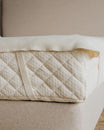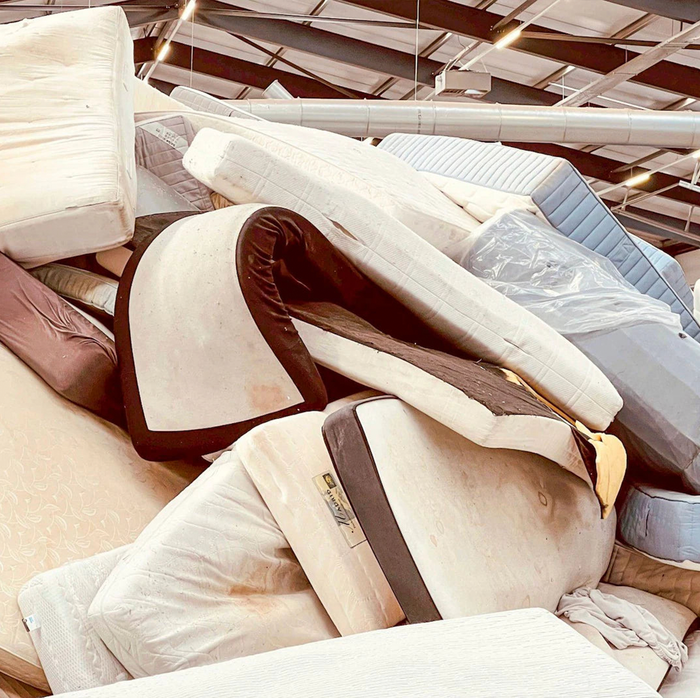What’s happening in the mattress industry today is nothing short of an environmental disaster. From one-sided mattresses to toxic raw materials, it is not easy for consumers to make educated decisions that are safe for the environment and their families.
In 2000, Simmons introduced the one-sided mattress and marketed it as maintenance-free, with no flipping or rotating required. The truth is, that the price of raw materials (mainly petroleum and steel) had skyrocketed and manufacturers needed a way to cut costs. In general, one-sided mattresses last between five to seven years, while a latex mattress can last 20-plus years. Because you cannot turn one-sided mattresses over, the only thing left to do is to rotate them, which puts you in your partner’s body impression. So, of course, this mattress will no longer work within the first couple of years. 20 years ago, you could flip and rotate your mattress, and increase its longevity. Now, it has become disposable. Approximately six million mattresses go into Canadian landfills each year, and the US discards three times that amount. Each mattress discarded, takes up valuable space in landfills, with components that do not break down; all the while releasing harmful toxins, and contaminating soil and water.
The biggest problem in the last five years, and the scariest one of them all, is the ubiquitous bed-in-a-box. There are dozens of these companies online which have followed the same business model. If you don’t like it you can return it!! What happens to the returned mattresses post-Covid? Most of them go to landfills. This business model is not sustainable and when you really look further into how people sleep, it is the shoulder collapse, and the resultant twist in our body that is causing problems. If customers were educated that the cause of their body pain could be related to this shoulder collapse, almost all returns could be avoided. Most mattress companies will blame your mattress for your discomfort, and thus, the cycle continues. It is clear that this model does not put the customer or the environment first.
In 2007, mattresses were required to pass a flammability test. Most conventional mattresses on the market today contain a blend of toxic chemicals. Alternatively, certified organic mattresses use wool as a natural and flame-safe barrier.
Hopefully one day, the bedding industry will be regulated. With the egregious use of landfill space, and the waste of raw materials and water used in production, it is obvious that change is imperative. This change needs to start with bedding manufacturers and consumer purchasing behaviour.
It’s not all bad - there is a bright side. After working in the mattress industry for over 25 years, I sympathize that consumers are being sold inferior products marketed with confusing, technical terminology that amounts to nothing but unsubstantiated jargon. I know we have to, and can do, better.
This consumer deception fueled my passion to find customizable solutions made from natural, organic materials. At Resthouse, we use low-impact, renewable resources that are free from plastics, pesticides and pollutants. Our materials are curated to be naturally breathable, moisture-wicking, hypoallergenic and dust mite resistant. No flame retardant chemicals are used on our natural latex mattresses, as the wool casing is naturally flame retardant.
As you move through the various stages of life, a customizable mattress allows you to change or move components for your comfort and support, without the need to get a new mattress. There is a mattress that can be built for you, that can change over time as your body ages and your needs transform. Our mattresses come in various depths and densities, and most include customization options that allow each partner to tailor their side of the bed to their individual sleeping preferences, body types, or unique needs.
While the upfront cost of an all-natural latex mattress might seem high compared to a conventional one-sided mattress, the cost is significantly lower when you consider that it has over four times the lifespan. Add to this the fact that if, and when, a natural rubber latex mattress does go to the landfill, all components are biodegradable and do not add to the waste problem.
Early on, I knew the key to a better sleep was body alignment, and stopping shoulder collapse; this enables us to enter into our deepest level of healthy, nourishing, sleep. With this in mind, we developed our Kakun brand, which focuses on customization, temperature regulation, and precision. Each of our three pillows come overstuffed, and can thus be tailored to an individual’s body type and sleep style. We developed a body pillow line with seven different models to choose from that support your body’s alignment, whether you are small, medium or tall. Our comforters can have two different weights in the same casing, as not everyone can sleep with the same weight. Each facet of our product line is tailored to the nuances that each individual sleeper experiences.
Sleep doesn’t have to be complicated, and it doesn’t have to be hot. Making educated decisions and purchasing customizable bedding will not only improve your sleep quality, it will also lessen your environmental impact.
Sweet dreams…and Happy Earth Day!
Written by Resthouse owner, Chris Manley for The Cowichan Valley Voice April 2024




















